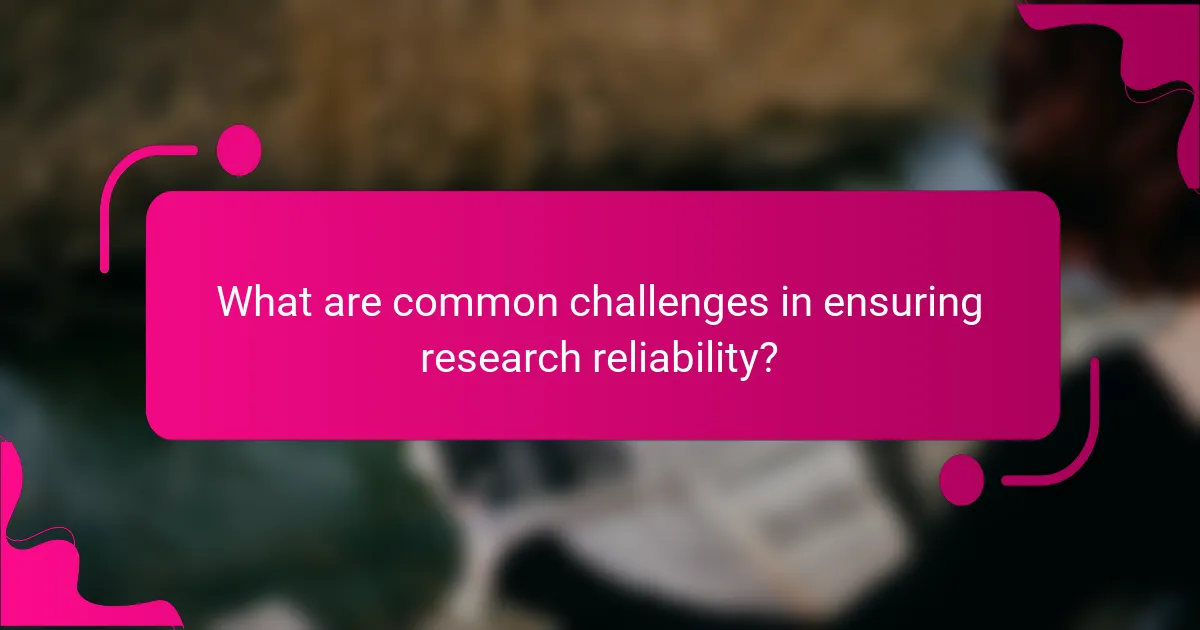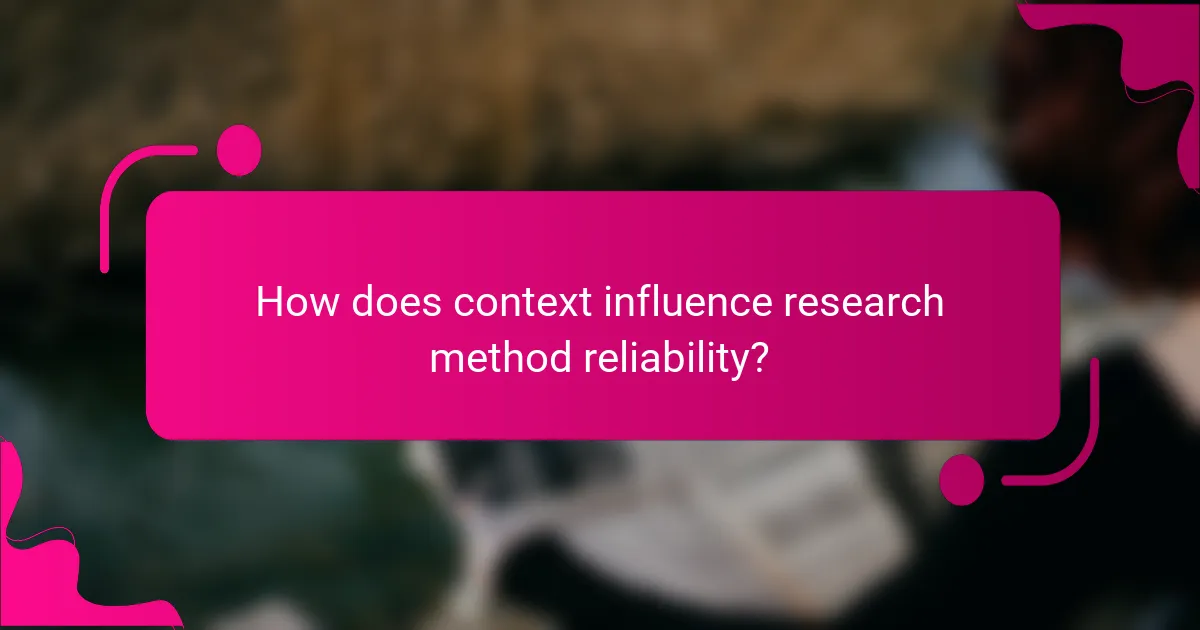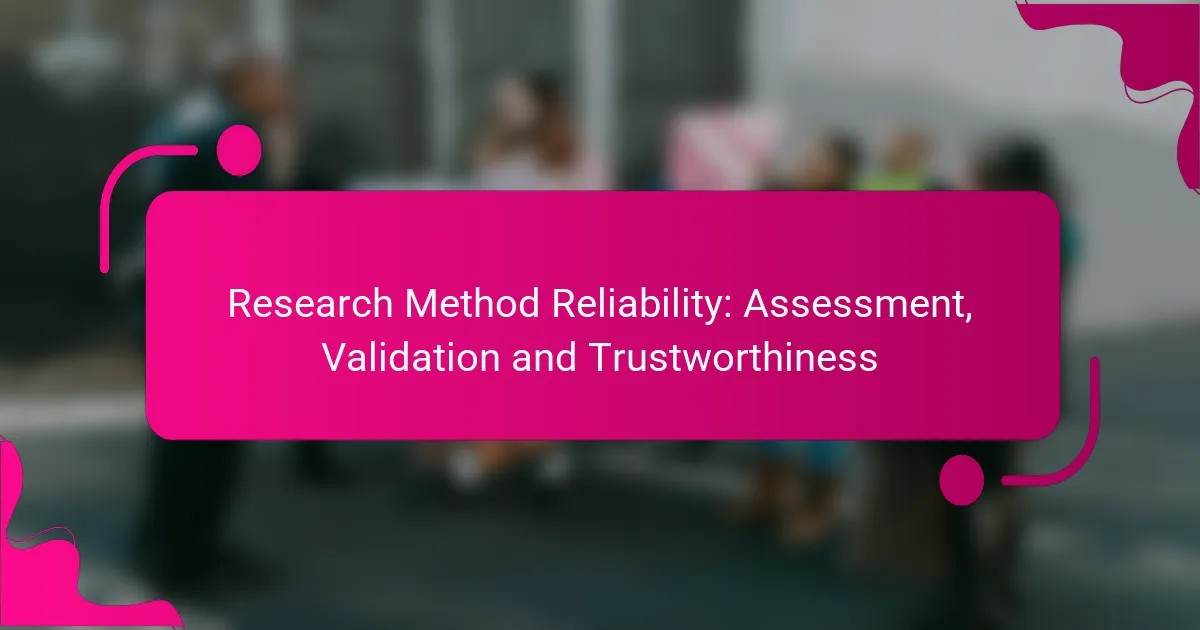Research method reliability is crucial for ensuring the consistency and accuracy of study findings. In the US, this assessment involves techniques such as statistical analysis and peer review, which enhance the trustworthiness of research. Employing validation methods like triangulation and longitudinal studies further supports the reliability of results, allowing for broader generalization across contexts.

How to assess research method reliability in the US?
Assessing research method reliability in the US involves evaluating the consistency and accuracy of the methods used in a study. This can be achieved through various techniques, including statistical analysis, peer review, and consistency checks.
Statistical analysis techniques
Statistical analysis techniques are essential for determining the reliability of research methods. Common approaches include calculating Cronbach’s alpha for internal consistency and using test-retest methods to measure stability over time. A Cronbach’s alpha value above 0.7 is typically considered acceptable for most research.
Researchers should also consider using confidence intervals and p-values to assess the precision and significance of their findings. These statistical tools help in understanding the variability and reliability of the data collected.
Peer review processes
Peer review processes play a crucial role in ensuring research method reliability. Submitting research to peer-reviewed journals allows experts in the field to evaluate the methodology, results, and conclusions. This scrutiny helps identify potential biases and methodological flaws.
To enhance reliability, researchers should seek feedback from multiple reviewers and be open to constructive criticism. Engaging with peers can lead to improvements in study design and execution, ultimately strengthening the research’s credibility.
Consistency checks
Consistency checks involve verifying that research methods yield stable and repeatable results across different contexts or samples. This can be done through repeated trials or using different data sets to confirm findings. For example, if a survey is administered multiple times, similar results should be expected if the method is reliable.
Researchers should document their procedures and results meticulously to facilitate these checks. Regularly revisiting and refining methods based on consistency outcomes can significantly enhance the overall reliability of research efforts.

What validation methods enhance research trustworthiness?
Validation methods that enhance research trustworthiness include triangulation of data sources and longitudinal studies. These approaches help ensure that findings are reliable and can be generalized across different contexts.
Triangulation of data sources
Triangulation involves using multiple data sources to validate research findings. This method increases credibility by comparing results from different perspectives, such as interviews, surveys, and observational data.
When employing triangulation, researchers should ensure that the data sources are complementary and relevant to the research question. For instance, combining qualitative interviews with quantitative survey results can provide a more comprehensive view of the topic.
Common pitfalls include relying too heavily on one source or failing to integrate findings effectively. Researchers should aim for a balanced approach, ensuring that each data source contributes to the overall understanding of the research problem.
Longitudinal studies
Longitudinal studies track the same subjects over an extended period, allowing researchers to observe changes and developments over time. This method is particularly useful for understanding trends and causal relationships.
When designing a longitudinal study, consider the duration and frequency of data collection. Studies that span several months to years can provide valuable insights, but they require careful planning to maintain participant engagement and data integrity.
Researchers should be aware of potential challenges, such as participant attrition and changes in context that may affect results. To mitigate these issues, maintaining regular communication with participants and adapting the study design as needed can be beneficial.

Which frameworks support reliable research methodologies?
Reliable research methodologies are supported by various frameworks that ensure validity, consistency, and trustworthiness. These frameworks guide researchers in selecting appropriate methods and assessing the quality of their findings.
Qualitative vs quantitative frameworks
Qualitative frameworks focus on understanding phenomena through in-depth exploration, often using interviews, focus groups, or observations. They provide rich, contextual insights but may lack generalizability due to smaller sample sizes.
Quantitative frameworks, on the other hand, emphasize numerical data and statistical analysis. They often involve larger samples and aim for objectivity, making findings more generalizable but potentially overlooking nuanced insights.
Mixed-methods approaches
Mixed-methods approaches combine qualitative and quantitative frameworks to leverage the strengths of both. This strategy allows researchers to validate findings through triangulation, enhancing the overall reliability of the research.
When using mixed methods, researchers should clearly define their objectives and determine how each method will contribute to answering the research questions. This approach can be particularly useful in fields like social sciences, where complex issues benefit from multiple perspectives.

What are common challenges in ensuring research reliability?
Common challenges in ensuring research reliability include issues related to sampling bias and data collection errors. These factors can significantly impact the validity of research findings, making it essential to address them effectively.
Sampling bias issues
Sampling bias occurs when the sample selected for a study does not accurately represent the population being studied. This can lead to skewed results and conclusions that do not reflect the true characteristics of the larger group.
To mitigate sampling bias, researchers should use random sampling techniques whenever possible. Ensuring diversity in the sample can help achieve a more representative outcome, which is crucial for the reliability of the research.
Data collection errors
Data collection errors can arise from various sources, including human mistakes, faulty instruments, or inappropriate methodologies. These errors can compromise the accuracy of the data, leading to unreliable results.
To minimize data collection errors, researchers should implement standardized procedures and regularly calibrate their instruments. Training data collectors thoroughly and conducting pilot tests can also help identify potential issues before the main study begins.

How does context influence research method reliability?
Context significantly affects research method reliability by shaping how data is collected, interpreted, and validated. Factors such as cultural norms, regional practices, and environmental conditions can all impact the trustworthiness of research findings.
Impact of cultural factors
Cultural factors play a crucial role in shaping research outcomes. Different cultures may have varying beliefs, values, and practices that influence how participants respond to surveys or interviews. For instance, in collectivist societies, individuals may prioritize group harmony over personal opinions, leading to biased responses.
Researchers must be aware of these cultural dynamics when designing studies. Utilizing culturally relevant methods and ensuring that questions are appropriately framed can enhance the reliability of the data collected. Engaging local experts can also provide insights into cultural nuances that affect participant behavior.
Regional differences in data interpretation
Regional differences can lead to variations in how data is interpreted and understood. For example, economic indicators may be perceived differently in developed versus developing regions, affecting the conclusions drawn from the same data set. Researchers should consider local economic contexts when analyzing results to avoid misinterpretation.
To improve reliability, researchers can employ region-specific benchmarks and standards that reflect local conditions. Collaborating with regional experts can also help ensure that interpretations align with local realities, thereby enhancing the overall trustworthiness of the research findings.

What role does technology play in research validation?
Technology plays a crucial role in research validation by enhancing the accuracy and efficiency of data collection and analysis. It enables researchers to utilize advanced tools and methodologies that improve the reliability and trustworthiness of their findings.
Use of AI in data analysis
Artificial Intelligence (AI) significantly enhances data analysis by automating complex processes and identifying patterns that may not be immediately apparent. For instance, machine learning algorithms can analyze large datasets quickly, providing insights that help validate research hypotheses.
When using AI, researchers should ensure the algorithms are trained on high-quality data to avoid biases. Regularly updating the models and validating their outputs against known benchmarks can help maintain the integrity of the analysis.
Online survey platforms
Online survey platforms facilitate the collection of data from diverse populations, making it easier to gather responses quickly and efficiently. These platforms often include built-in tools for data validation, such as logic checks and response quality assessments, which enhance the reliability of the collected data.
When selecting an online survey platform, consider factors such as user interface, accessibility, and data security. Popular options include SurveyMonkey and Google Forms, which offer various features to support effective research validation.
